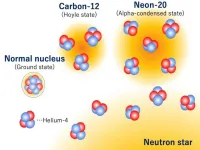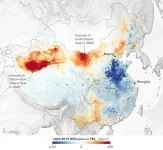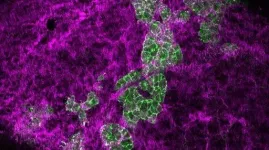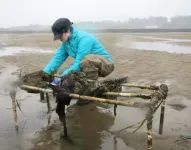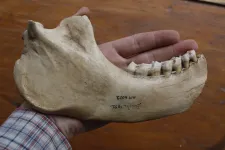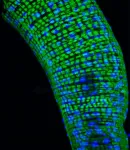Plant Protector: How plants strengthen their light-harvesting membranes against environmental stress
2021-06-24
(Press-News.org) An international study led by Helmholtz Zentrum München has revealed the structure of a membrane-remodeling protein that builds and maintains photosynthetic membranes. These fundamental insights lay the groundwork for bioengineering efforts to strengthen plants against environmental stress, helping to sustaining human food supply and fight against climate change.
Plants, algae, and cyanobacteria perform photosynthesis, using the energy of sunlight to produce the oxygen and biochemical energy that power most life on Earth. They also adsorb carbon dioxide (CO?) from the atmosphere, counteracting the accumulation of this greenhouse gas. However, climate change is exposing photosynthetic organisms to increasing environmental stress, which inhibits their growth, and in the long term, endangers the food supply of humankind.
The important first steps of photosynthesis are performed within the thylakoid membranes, which contain protein complexes that harvest sunlight. For decades, it has been known that the protein VIPP1 (vesicle-inducing protein in plastids) is critical for forming thylakoid membranes in almost all photosynthetic organisms - from plants on land to algae and cyanobacteria in the ocean. However, it has remained a mystery how VIPP1 performs this essential function. In the latest issue of the journal Cell, a new study by an international consortium of researchers led by Ben Engel from the Helmholtz Pioneer Campus at Helmholtz Zentrum München reveals the structure and mechanism of VIPP1 with molecular detail.
Building and protecting photosynthetic membranes
The researchers used cryo-electron microscopy to generate the first high-resolution structure of VIPP1. Combining this structural analysis with functional assays revealed how VIPP1 assembles into an interwoven membrane coat that shapes the thylakoid membranes. The research group also used the cutting-edge approach of cryo-electron tomography to image VIPP1 coats within the native environment of algae cells. By using the structural information to make specific mutations to VIPP1, the researchers observed that the interaction of VIPP1 with thylakoid membranes is critical to maintain the structural integrity of these membranes under high-light stress. "Our study shows how VIPP1 plays a central role in both thylakoid biogenesis and adaptation of thylakoids to environmental changes," explains first author Tilak Kumar Gupta from the Max Planck Institute of Biochemistry.
This study lays the foundation for a mechanistic understanding of thylakoid biogenesis and maintenance. It also provides new opportunities for engineering plants that are more resistant to extreme environmental conditions. "Insights into the molecular mechanisms controlling thylakoid remodeling are an important step towards developing crops that not only grow faster, have higher yield and resistance to environmental stress, but also absorb more atmospheric CO? to counteract climate change," says study leader Ben Engel.
International team research
This interdisciplinary study brought together the talents of research teams from the Technische Universität Kaiserslautern (Michael Schroda), Philipps-Universität Marburg (Jan Schuller), Ludwig-Maximilians-Universität München (Jörg Nickelsen), Okayama University in Japan (Wataru Sakamoto), McGill University in Canada (Mike Strauss), Ruhr-Universität Bochum (Till Rudack), the Max Planck Institute of Biochemistry (Wolfgang Baumeister and Jürgen Plitzko) and Helmholtz Zentrum München. "Our study covers a lot of new ground using a wide variety of techniques. This was only possible thanks to the tremendous collective efforts of the researchers in our international consortium," says Ben Engel.
INFORMATION:
[Attachments] See images for this press release:
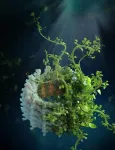
ELSE PRESS RELEASES FROM THIS DATE:
2021-06-24
Men - more often than women - need passion to succeed at things. At the same time, boys are diagnosed as being on the autism spectrum four times as often as girls.
Both statistics may be related to dopamine, one of our body's neurotransmitters.
"This is interesting. Research shows a more active dopamine system in most men" than in women, says Hermundur Sigmundsson, a professor at the Norwegian University of Science and Technology's (NTNU)Department of Psychology.
He is behind a new study that addresses gender differences in key motivating factors for what it takes to become good at something. The study uses men's and women's differing activity in the dopamine system as an explanatory model.
"We looked at gender differences around passion, self-discipline ...
2021-06-24
Researchers from Skoltech and their colleagues have shown that adaptation to similar environments hardly involves similar genomic positions when species are distantly related. The team investigated recurrent adaptations of wildlife birds' mitochondria to high altitude, migration, diving, wintering, and flight. Repeatable substitutions are rather a coincidence than adaptation, which confirms the scientific opinion that distant species "choose" different ways of similar trait evolution. The paper was published in the journal Genome Biology and Evolution.
If an organism wants to survive in unusual conditions, such as oxygen starvation typical for high altitudes or elevation of metabolism rate due to extreme temperatures, it has to adapt. If different species meet similar environment ...
2021-06-24
Osaka, Japan - Scientists from the Department of Physics and the Research Center for Nuclear Physics (RCNP) at Osaka University, in collaboration with Kyoto University, used alpha particle inelastic scattering to show that the theorized "5α condensed state" does exist in neon-20. This work may help us obtain a better understanding the low-density nucleon many-body systems.
All elements besides hydrogen and helium must have been fused inside the nuclear furnace of a star. The yield during these reactions of carbon-12, which has six protons and six neutrons, is increased by an ...
2021-06-24
Early in the pandemic, it was expected that satellite imagery around the world would show cleaner air as a result of COVID-19 lockdowns. But not all pollutants were taken out of circulation. For tiny airborne-particle pollution, known as PM 2.5, researchers using NASA data found that variability from meteorology obscured the lockdown signals when observed from space.
"Intuitively you would think if there is a major lockdown situation, that we would see dramatic changes, but we didn't," said Melanie Hammer, a visiting research associate at Washington University in St. Louis who led the study. "It was kind of a surprise ...
2021-06-24
Tooth loss is often accepted as a natural part of aging, but what if there was a way to better identify those most susceptible without the need for a dental exam?
New research led by investigators at Harvard School of Dental Medicine suggests that machine learning tools can help identify those at greatest risk for tooth loss and refer them for further dental assessment in an effort to ensure early interventions to avert or delay the condition.
The study, published June 18 in PLOS ONE, compared five algorithms using a different combination of variables to screen for risk. The results showed those that factored medical characteristics and socioeconomic variables, such as race, education, arthritis, and diabetes, outperformed algorithms that relied on dental clinical indicators alone.
"Our ...
2021-06-24
A new resource developed at the Garvan Institute of Medical Research and The Kinghorn Cancer Centre for oncologists could help make targeted cancer therapies more accessible for Australian patients.
The TOPOGRAPH (Therapy-Oriented Precision Oncology Guidelines for Recommending Anti-cancer Pharmaceuticals) database is an online tool that catalogues oncology research to streamline the process of recommending therapeutic treatments in precision cancer medicine.
Garvan Senior Research Officer Dr Frank Lin led the development of the platform reported this week in the journal npj Precision Oncology.
"TOPOGRAPH is uniquely useful in the Australian context because it combines ...
2021-06-24
Wastewater treatment facilities clean the water that goes down our sinks and flushes our toilets, but they do not remove everything. A recent study by Portland State researchers detected low levels of pharmaceuticals and personal care product chemicals in oysters the team deployed at various distances from wastewater effluent pipes along the Oregon and Washington coast. Elise Granek, professor of environmental science and management at Portland State University, and Amy Ehrhart, a recent graduate of PSU's Earth, Environment, and Society doctoral program, conducted the study.
To explore how aquatic pollution varies based on proximity to wastewater facilities, Ehrhart and Granek placed one-week-old ...
2021-06-24
Researchers at Harvard University and the Broad Institute of MIT and Harvard have created a first detailed atlas of a critical region of the developing mouse brain, applying multiple advanced genomic technologies to the part of the cerebral cortex that is responsible for processing sensation from the body. By measuring how gene activity and regulation change over time, researchers now have a better understanding of how the cerebral cortex is built, as well as a brand new set of tools to explore how the cortex is affected in neurodevelopmental disease. The study is published in the journal Nature.
"We have had a long-standing interest in understanding the development of the mammalian cerebral cortex, as it is ...
2021-06-24
UNIVERSITY PARK, Pa. -- Using an unusually well-preserved subfossil jawbone, a team of researchers -- led by Penn State and with a multi-national team of collaborators including scientists from the Université d'Antananarivo in Madagascar -- has sequenced for the first time the nuclear genome of the koala lemur (Megaladapis edwardsi), one of the largest of the 17 or so giant lemur species that went extinct on the island of Madagascar between about 500 and 2,000 years ago. The findings reveal new information about this animal's position on the primate family tree and how it interacted with its environment, which could help in understanding the impacts of past lemur extinctions on Madagascar's ecosystems.
"More than 100 species of lemurs live on Madagascar today, ...
2021-06-24
To better understand the role of bacteria in health and disease, National Institutes of Health researchers fed fruit flies antibiotics and monitored the lifetime activity of hundreds of genes that scientists have traditionally thought control aging. To their surprise, the antibiotics not only extended the lives of the flies but also dramatically changed the activity of many of these genes. Their results suggested that only about 30% of the genes traditionally associated with aging set an animal's internal clock while the rest reflect the body's response to bacteria.
"For ...
LAST 30 PRESS RELEASES:
[Press-News.org] Plant Protector: How plants strengthen their light-harvesting membranes against environmental stress

